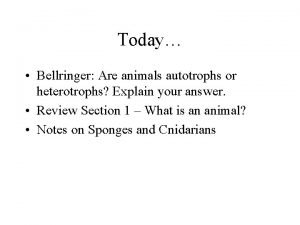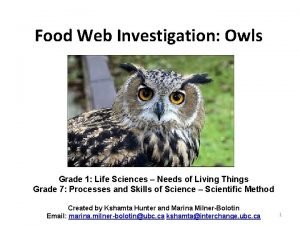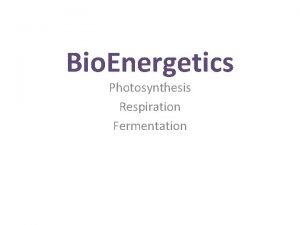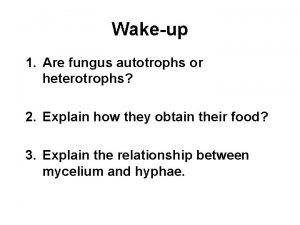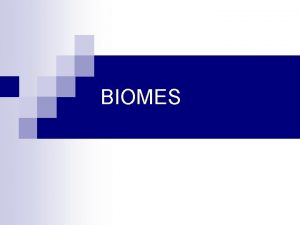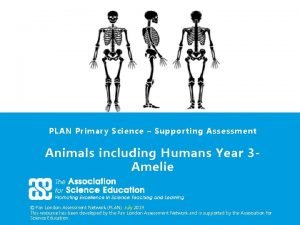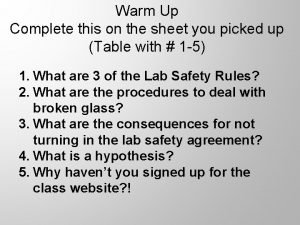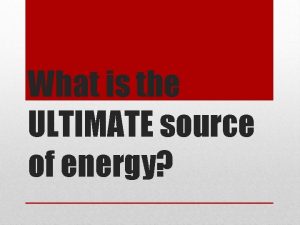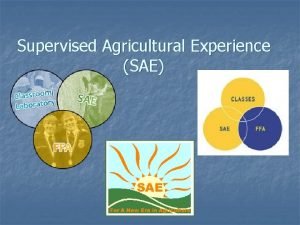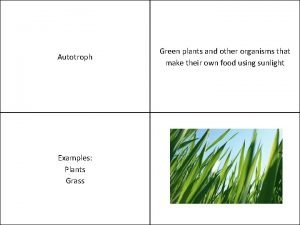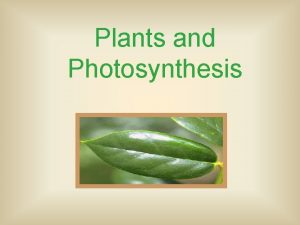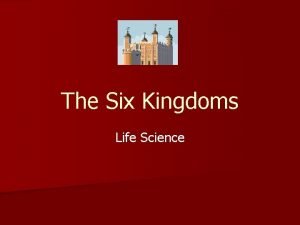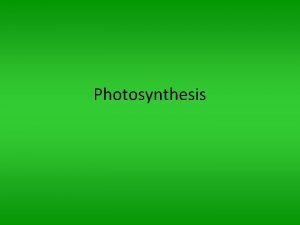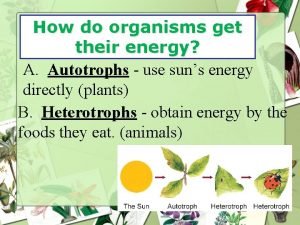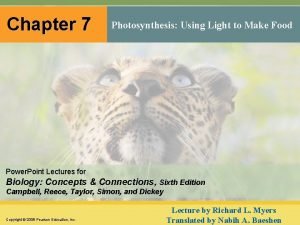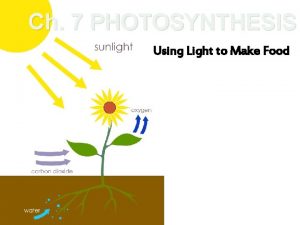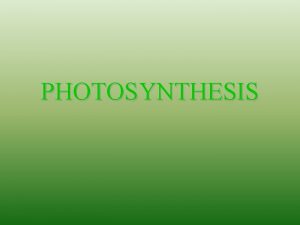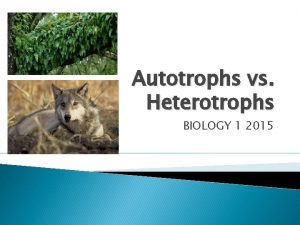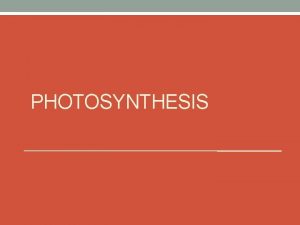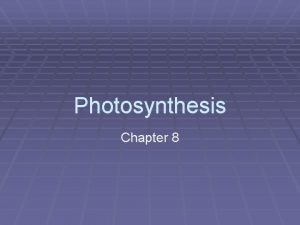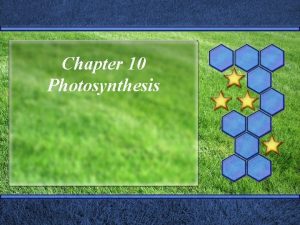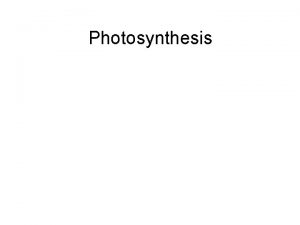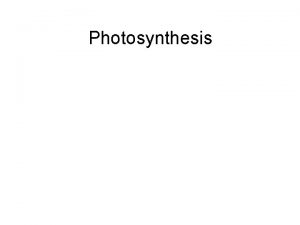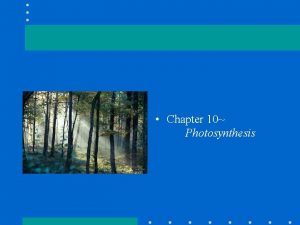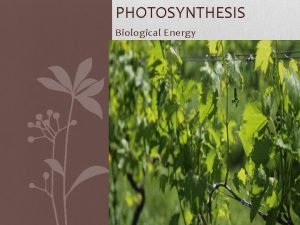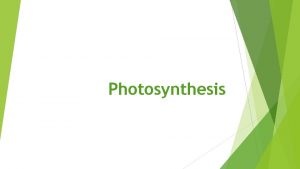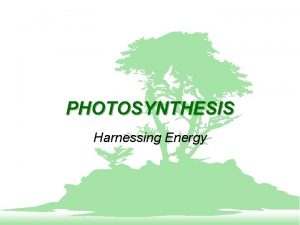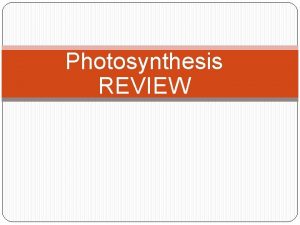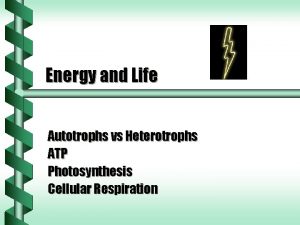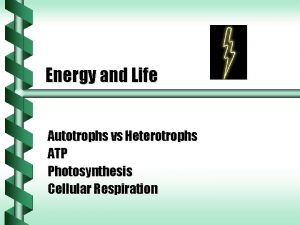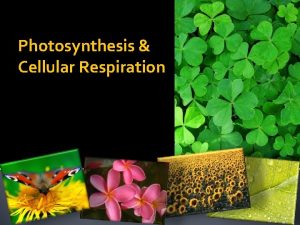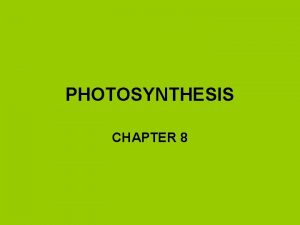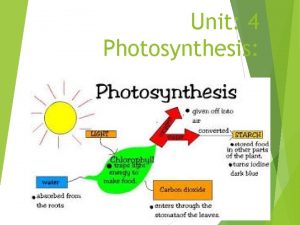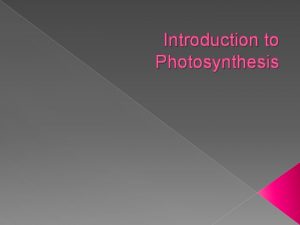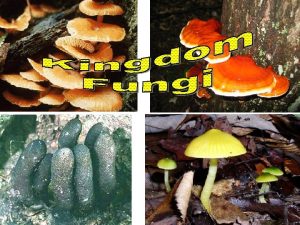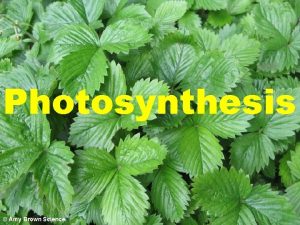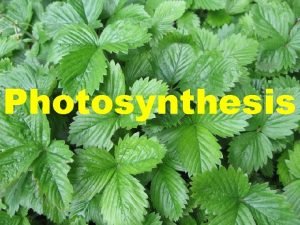Photosynthesis Autotrophs make their own energy Heterotrophs have























- Slides: 23

Photosynthesis • Autotrophs- make their own energy • Heterotrophs – have to consume energy

• Cells use stored chemical energy – ATP – adenosine triphosphate • Adenine – nitrogen, Ribose – 5 C sugar, 3 Phosphates • Full Battery – ADP – adenosine diphosphate – 2 phosphates - Half full battery

Notes 3. 1 Summarize the overall process by which photo converts solar energy into chemical energy. • The ultimate source of energy for most life on earth is the sun. Photosynthesis is the overall process by which sunlight chemically coverts water and carbon dioxide into chemical energy stored in sugars (glucose).

6 CO 2 + 6 H 2 O C 6 H 12 O 6 + 6 O 2 carbon dioxide + water sugar + oxygen

• Chlorophyll – main pigment in plants, – Green – chlorophyll a and b, Red – anthocyanins, Orange and Yellow – carotenoids. – Absorbs light very well in the blue and red, NOT in the green light. – Chlorophyll reflects green – In fall, when deciduous trees shed leaves to conserve energy, they stop photosynthesizing and true underlying colors, yellow, orange, red, are present.



Absorbtion diagram

Reactions of Photosynthesis • All processes of photosynthesis take place in the chloroplast. • 2 phases of photosynthesis: – 1. light-dependent rxn – 2. light-independent rxn (Calvin Cycle)

Figure 8 -7 Photosynthesis: An Overview Section 8 -3 Water CO 2 Chloroplast NADP+ ADP + P Light. Dependent Reactions O 2 Calvin Cycle ATP NADPH Sugars

Light Dependent Rxn • Requires light • Within the thylakoid membrane • Solar energy is absorbs by chloroplast and 2 energy storing molecules ATP and NADPH are produced. • These are then used in the next phase. • The solar energy is used to split 2 water molecules which results in the release of oxygen as a waste product, an essential step in the process of photosynthesis.



Figure 8 -10 Note: Reactions move from left to right on the figure, from photsystem II through the electron transport chain to photosystem I. Questions: 1. Where are these light dependent reactions occurring? 2. Where is water broken down? 3. Where are two places chlorophyll absorbs the energy of sunlight? 4. Where and how is ATP produced in the process? 5. How is NADPH produced in the process?

Answers: • Within the thylakoid membrane of a chloroplast. • Water is broken down on the inner surface of the thylakoid membrane. • In photosystem II and photosystem I. • ATP is produced as H+ ions pass thought ATP synthase, as shown to the right of photosystem I. • NADPH is produced when NADP+ picks up highenergy electrons from photosystem I at the outer surface of the thylakoid membrane.

Light Independent Rxn or Calvin Cycle or Dark Rxn • Requires no light • Occurs within the stroma (space outside the grana)

During the light independent rxn, energy stored in ATP and NADPH is used to produce glucose from carbon dioxide. These simple sugars are used to store chemical energy for use by the cell at later times.


Final products – Calvin cycle uses 6 CO 2 to produce a single 6 carbon sugar molecule. (glucose) • ATP and NADPH are quick energy. Made in the light dependent rxn, but then fed into the Calvin Cycle and used to turn into higher energy for the cell to use. (Sugars and glucose)



Figure 8 - 11 pg 120 Questions: 1. Where does the Calvin cycle take place? 2. What enters the Calvin cycle from the atmosphere? 3. Where do the ATP and NADPH come from? 4. What is the product of this cycle? 5. How is the cycle complete?

Answers 1. It take place in the stroma, outside the grana. 2. Six CO 2 molecules. 3. Both STP and NADPH come from the lightdependent reactions. 4. Two 3 -carbon molecules 5. The cycle is complete when the remaining 3 -carbon molecules are converted back into 5 -carbon molecules, which are ready to combine with new carbon dioxide molecules to begin the cycle again.
 Hollow bodied animals
Hollow bodied animals Do owls eat
Do owls eat Autotrophs and heterotrophs
Autotrophs and heterotrophs Creeping stem
Creeping stem Heterotroph kingdom
Heterotroph kingdom Are bacteria autotrophs or heterotrophs
Are bacteria autotrophs or heterotrophs Explain how adp and atp are each like a battery
Explain how adp and atp are each like a battery Photosynthesis glossary
Photosynthesis glossary Green plants make their own food by photosynthesis
Green plants make their own food by photosynthesis Animals can make their own food
Animals can make their own food Animals can make their own food
Animals can make their own food Organisms that make their own food
Organisms that make their own food Whats a decomposer
Whats a decomposer Photosynthesis transforms light energy into chemical energy
Photosynthesis transforms light energy into chemical energy Analytical sae examples
Analytical sae examples Is grass autotroph or heterotroph
Is grass autotroph or heterotroph Granum
Granum Which of the following is false about protists?
Which of the following is false about protists? The six kingdoms
The six kingdoms Autotrophs
Autotrophs Which organism is an autotroph
Which organism is an autotroph The process of photosynthesis
The process of photosynthesis Is photosynthesis a redox reaction
Is photosynthesis a redox reaction 8 faces 12 vertices
8 faces 12 vertices
